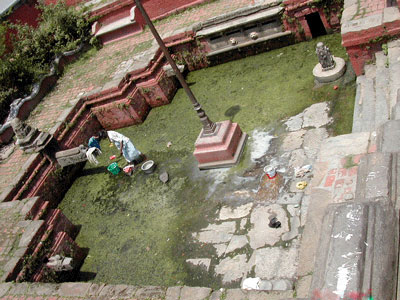

The place you’ve just entered takes its name from Naag, the serpent protector of the courtyard residents, who is also associated with the rains and with
fertility. No feast or puja (prayer ceremony) here is complete without the residents first making offerings to the serpent deity. The central portion of the
baha, with shruds and trees, is set off by a low wall topped with a railing.
As you begin walking clockwise around the courtyard, you come to a statue of a bull painted a smooth white and protected by railings and a metal canopy.
Dipankar Buddha (who preceded the historical Sakyamuni Buddha by a few eons) once visited the shrine at Naga Baha and a bull that was grazing here heralded
his arrival. This bull, who is commemorated by the statue, had the power to conjure as much food as was necessary during feasts-and Patan’s people are
renowned for their feasting to this day.
Just ahead, on the far side of the courtyard, you come to a hiti, a sunken structure with a stone water spout at the base. Besides wells these water spoutes
are the primary source of clean water for Patan’s residents to drink, wash and bathe. There are dozens of such hitis still working in teh city, with
ornamental spouts of stone often depicting Makara, the mythical water dragon. The hitis are fed by springs which are guided to the spouts through underground
channels, often over long distances.
Look down into the Naga Baha hiti, and you will see chaityas said to be among the oldest in Patan town. Close by, you will see two barred patis, with images
of snakes within each. These colorful, popular murals are repainted every five years for the Samyak Puja, a religious ceremony during which more than a score
of life-size Buddha statues are assembled here. Ten of thousands come to worship this unique collection of sacred statues, which emerge from the 16 main bahas
of Patan and the nearby southern Valley towns of Bungamati, Chobar and Kirtipur.
Samyak is a major Patan festival. The collection of large Buddha statues, each with its own distinctive facial features, is a unique event. The last Samyak
was in 1996, and the serpent protectors of Naga Baha are due for repainting in 2001.
Countinue walking clockwise and on your right you will come across a collection of large chaityas, some of which date back to the Lichhavi era. (the Lichhavi
dynasty ruled from the period have stubbier domes than later ones.) At centre of the courtyard, adorned by some shrubs, is a tile-roofed building which does
not look very much like a temple, but which does contain an image of Aksobhaya, the Transcendent Buddha.
Directly opposite where you entered Naga Baha, there is a passageway leading under a very old, but not very ornate agam building which holds a tantrik shrine.
Emerging on the oler side, you are greeted by the image of a painted Ganesh statue housed in an open pati-like temple. Along the right side of the courtyard
are the eaves and carved windows of the library of the Hiranya Varna Mahavihar monastery, which is the neighbouring courtyard. Follow the diagonal brick path
across the chowk till you arrive at an elaborately carved rock stupa. Behind it is an extremely well-preserved agam. showcasing Patan’s woodcarving heritage.
Proceed on the path, and in a few steps you arrive at the corner of the courtyard. Passing under a wooden toran (a semicircular decorative panel over the
entrance to shrines. whose principal feature is often Makara, the stylised crocodile), you enter one of the most fascinating temple com-plexes of Kathmandu
Valley. This is the Hirnaya Varna Mahavihar, a monastery known to the people of Patan as Kwa Baha and referred to in tourist literature as the Golden Temple
because of its gleaming gilt roofs.
 The place you’ve just entered takes its name from Naag, the serpent protector of the courtyard residents, who is also associated with the rains and with
fertility. No feast or puja (prayer ceremony) here is complete without the residents first making offerings to the serpent deity. The central portion of the
baha, with shruds and trees, is set off by a low wall topped with a railing.
The place you’ve just entered takes its name from Naag, the serpent protector of the courtyard residents, who is also associated with the rains and with
fertility. No feast or puja (prayer ceremony) here is complete without the residents first making offerings to the serpent deity. The central portion of the
baha, with shruds and trees, is set off by a low wall topped with a railing.